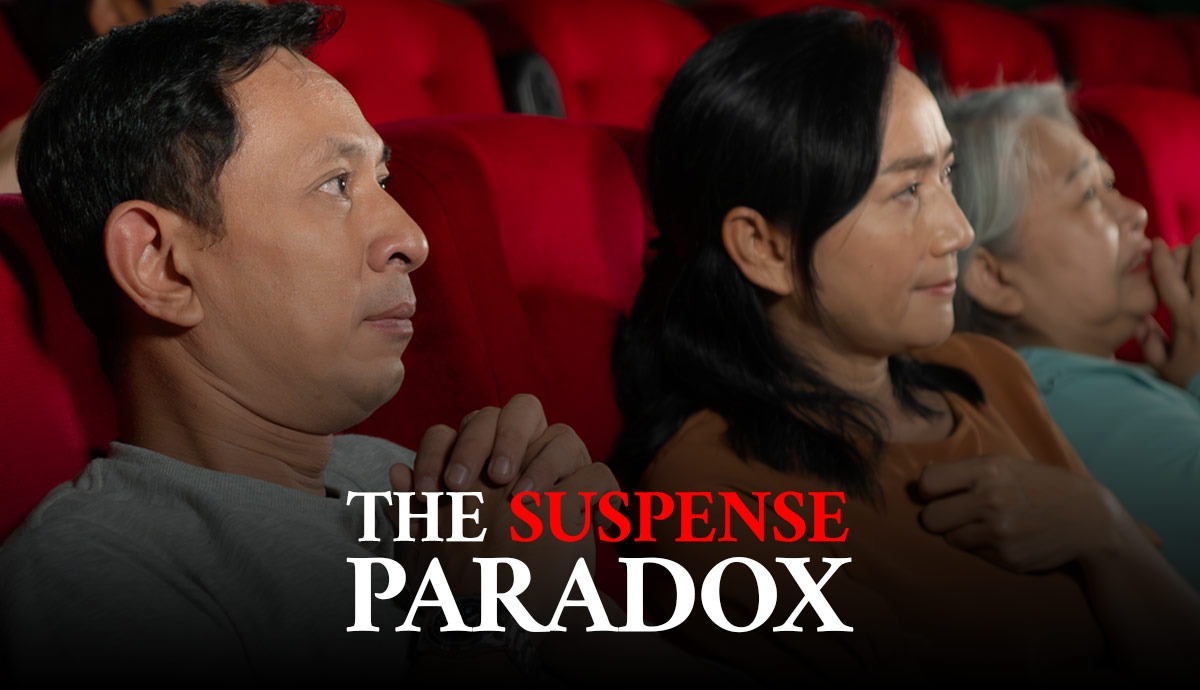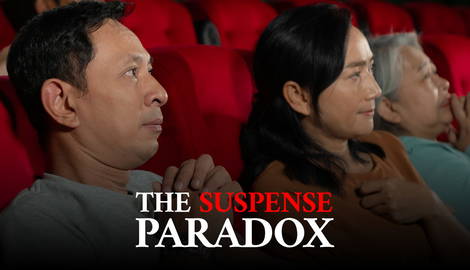
As any casual viewer would notice, it is extremely difficult to enjoy a book or a film of suspense twice. The idea of a suspenseful story is to, well, be suspenseful, which is only possible on the first viewing. Every subsequent viewing robs us of such enjoyment. Could we, then, find a solution to this paradox? According to experts, there are several possible solutions.
Possible Solutions to the Suspense Paradox

Think of a mystery novel (akin to those of Agatha Christie) or think of a suspense film (like those of Alfred Hitchcock) and ask yourself how many times you have seen or read those works. Unless you are a film critic or a devout fan of an author, the answer will probably be: just one time. There is a very logical reason for this. Namely, after we come to know the ending, the suspense disappears. No repeat viewings could recreate the same feeling of mystery, uncertainty, and excitement. Yet, for some people, the film/novel could still feel suspenseful despite knowing the ending. This is called the paradox of suspense.
Formally, we state it as follows:
1. Suspense relies on uncertainty.
2. Knowing the story’s outcome hinders uncertainty.
3. Yet, people can still feel suspense despite knowing the outcome.
Although none of these claims are problematic by themselves, together, they are inconsistent. Namely, if viewers seek uncertainty, which disappears once the outcome is known, how can they feel suspense again? For a visual understanding of what paradoxes are, look at the famous rabbit/duck illusion, where we seem to observe two things at once.

Philosophers have proposed four solutions to this paradoxical conundrum. The first, known as entertained uncertainty (linked to Noël Carroll), rejects the first premise and uncertainty altogether. Another solution, the desire-frustration theory, (usually associated with Aaron Smuts) also denies the first claim, suggesting that what creates suspense is the thwarting of a desire to influence an imminent event. The moment-by-moment forgetting theory (linked to Richard Gerrig) challenges the second premise, while the emotional misidentification theory disputes the third (proposed by Robert Yanal).
Solution #1: Thought Theory

If you are a cinema enthusiast, you must have seen Alfred Hitchcock’s Psycho, a classic of cinematic suspense. The whole film is an exciting and tension-filled ride. But why does the film feel so suspenseful? Noël Carroll believes that one doesn’t necessarily require real uncertainty about what will happen; just the act of imagining different outcomes can be suspenseful by itself. Even if we are familiar with all the twists and turns of Psycho, we still feel some excitement because we can still imagine what might happen.
Carroll calls this the thought theory. He sees storytelling as a kind of guided imagination, where we entertain thoughts without actually taking them for real, i.e. we don’t believe in them. Think about a fictional film event, like the gruesome shower scene in Psycho. Carroll says our emotions in fiction come from letting our imagination run wild with these unreal scenarios.
However, there’s a catch. Why does uncertainty fade upon rewatching a film? Carroll’s approach is unable to explain this; it also doesn’t address cases where knowing the outcome actually makes a story more suspenseful, like when re-watching Psycho. Even if we eliminate uncertainty, we are still left with a paradox: on a second viewing, the suspense diminishes.
Solution #2: Desire-Frustration Theory

Another philosopher of art and aesthetics, Aaron Smuts, supports the desire-frustration theory of suspense, arguing that the key to suspense is the frustration of a desire to influence a near-future event. Smuts argues that uncertainty is not a necessary or sufficient condition for suspense. Famous films of suspense, like Psycho, are re-watched for many reasons, and one could argue they get more and more suspenseful on repeated viewings.
Smuts emphasizes that our feeling of suspense comes from powerlessness, unlike real life, where we can actively influence the outcomes of events. The viewers are seated in their armchairs observing events without being able to participate. However, the theory wonders why suspenseful events need to be imminent and whether identifiable frustrated desires are always necessary for suspense. Moreover, critics contend that the desire to alter a fictional world is inherently impossible to fulfill and might be seen as something unusual, implausible, and ultimately unachievable.
A director of contemporary cinema, David Fincher, known for his exciting thrillers and chilling crime dramas, could help us approach the paradox with a pair of fresh eyes. Namely, we could apply the desire-frustration theory to his cinematic hit Seven (1995). The film follows two detectives—played by Morgan Freeman and Brad Pitt—trying to uncover the identity of a serial killer. Viewers are gripped by suspense as the detectives’ desire to apprehend the killer is continually thwarted by the mysterious and gruesome nature of the crimes. The viewers do not derive suspense from knowing or not knowing the ending, but rather by identifying with the detectives and their frustration of finding and ultimately apprehending the killer. Simply put, even after the killer is revealed, the film can be rewatched and suspense is still derived from the journey the detectives take.
Solution #3: Moment-by-Moment Forgetting

Richard Gerrig proposes the moment-by-moment forgetting theory to resolve the paradox of suspense. Unlike the previous explanations, Gerrig insists that, after all, suspense does require uncertainty. He challenges the idea that knowing a story’s outcome eliminates uncertainty, arguing that people can both know the ending and still be uncertain about unfolding events. He lists many different films that have incited viewers to rewatch them. Gerrig attributes this to our cognitive limitations, suggesting that our evolutionary history didn’t equip us to recall known outcomes in the midst of similar scenarios.
However, Gerrig’s theory is not immune to flaws. What happens when we are faced with scenarios where suspense unfolds gradually? Moreover, many critics are skeptical about our cognitive limitations, pointing out that we often rapidly make decisions in stressful situations. Additionally, Gerrig’s theory cannot seem to explain why suspense diminishes upon repeated viewings and fails to account for the common experience of noticing new details in familiar stories, which contradicts the theory’s assertion of moment-by-moment forgetting.
Solution #4: Emotional Misidentification Theory

Last, but not least, philosopher Robert Yanal proposes the emotional misidentification approach as a resolution to the paradox by denying that viewers genuinely feel suspense on repeated encounters with films they have watched before. He argues that no viewing experience can be repeated, only misidentified. If a viewer perceives a film as just as suspenseful on multiple viewings, they must be confused to mislabel their emotional response as suspense when it’s actually anticipation.
His theory relies on a clear distinction between anticipation and suspense, claiming that genuine suspense requires cognitive uncertainty. But, what is the real difference between these emotional states? Do film viewers really misidentify their emotional responses? Yanal extends this reasoning to fear, arguing that the same issue arises when feeling fear in response to familiar events where the outcome is known. Yanal’s theory implies that our ability to self-reflect on feelings of suspense and fear may be imperfect. However, this might be due to the fact that suspense is quite complex, a mixture of fear and hope, making it difficult to define.
Let’s examine Hitchcock’s Rear Window (1954), to point out the limitations of this theory. The protagonist (played by James Stewart), always in a wheelchair, serves as the audience surrogate, while the other characters are constantly doing something outside his window. He is a silent observer, just like the audience. The emotional misidentification view invites us to question whether the repeated viewers genuinely experience suspense, or whether they are merely mislabeling their emotional response.
Is The Suspense Paradox Resolved?

In trying to untangle the suspense paradox, four different approaches were presented: the thought theory, the desire-frustration theory, the moment-by-moment forgetting approach, and the emotional misidentification approach. The thought theory and desire-frustration theory share an overlap: tackling suspense even when we know the story’s outcome. Both theories explore the psychological nuances that govern the spectators’ expectations and attitudes, and both explore how suspense comes about in our minds.
On the other hand, the moment-by-moment forgetting theory challenges our very assertions of certainty. This theory argues that our mind’s abilities are somewhat limited, as we struggle to recall known outcomes, this theory makes us reconsider the connection between memory and suspense. Finally, the emotional misidentification view proposes that the episodic encounters we call suspenseful are, in fact, nothing more than anticipation. Instead, we need to confront the real character of our emotions. Is what we feel genuine suspense or a misinterpretation of our emotional response?

How successful were the proposed theories at resolving the paradox? The perfect resolution should go beyond the mere disentanglement of the puzzle. A solid theory about suspense should account for the real intensity of suspense. It’s like navigating this interesting space where excitement, all tangled up with not knowing what’s going to happen, goes back and forth each time you watch it again.
As we consider and evaluate these theories, one has to admit that suspense is rarely part of our everyday lives, discounting our occasional trips to the cinema. It makes us wonder why the emotional connection we feel with stories does not smoothly translate into those nail-biting moments we find in cinema, literature, or other forms of storytelling.
In our quest for understanding, we demand a theory that not only breaks down the paradox but also unravels the connection between anticipation and uncertainty. That’s where the real magic of suspense resides, capturing our hearts and minds in the mysterious art of storytelling.







